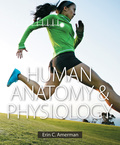
EBK HUMAN ANATOMY & PHYSIOLOGY
16th Edition
ISBN: 8220100659836
Author: AMERMAN
Publisher: PEARSON
expand_more
expand_more
format_list_bulleted
Concept explainers
Textbook Question
Chapter 11, Problem 15CYR
Mark the following statements as true or false. If a statement is false, correct it to make a true statement.
a. The resting membrane potential refers to the voltage difference across the membranes of excitable cells at rest.
b. The concentration of Na+ is highest in the cytosol, and the concentration of K+ is highest in the extracellular fluid.
c. The Na+/K+ pumps and gated channels maintain the Na+ and K+ gradients necessary for action potentials to occur.
d. A depolarization is a change in membrane potential that makes the potential less negative.
e. A local potential is a change in membrane potential that conducts the long-distance signals of the nervous system.
Expert Solution & Answer
Want to see the full answer?
Check out a sample textbook solution
Chapter 11 Solutions
EBK HUMAN ANATOMY & PHYSIOLOGY
Ch. 11.1 - What are the organs of the CNS?Ch. 11.1 - Prob. 2QCCh. 11.1 - Describe the sensory, integrative, and motor...Ch. 11.1 - 4. What are the differences between the somatic...Ch. 11.1 - How does the somatic motor division of the PNS...Ch. 11.2 - What are the functions of the cell body,...Ch. 11.2 - What are the structural differences between...Ch. 11.2 - What are the functional differences between...Ch. 11.2 - What are the functions of astrocytes?Ch. 11.2 - Prob. 5QC
Ch. 11.2 - Prob. 6QCCh. 11.2 - 7. What is the function of the myelin sheath?
Ch. 11.2 - How does the myelin sheath differ in the CNS and...Ch. 11.2 - Are neurons more likely to regenerate in the CNS...Ch. 11.2 - Prob. 10QCCh. 11.3 - 1. What is the resting membrane potential?
Ch. 11.3 - Prob. 2QCCh. 11.3 - What two factors generate the resting membrane...Ch. 11.3 - Prob. 4QCCh. 11.3 - Prob. 5QCCh. 11.3 - In and around the axon, where is the higher...Ch. 11.3 - What is the resting membrane potential, and what...Ch. 11.3 - Prob. 8QCCh. 11.3 - Prob. 9QCCh. 11.3 - Prob. 10QCCh. 11.3 - What takes place during the depolarization phase...Ch. 11.3 - 7. What must be reached in order for...Ch. 11.3 - 8. What takes place during the repolarization and...Ch. 11.3 - 9. What are the absolute and relative refractory...Ch. 11.3 - 10. How do local potentials and action potentials...Ch. 11.3 - Which is useful for long-distance signaling, and...Ch. 11.3 - 12. How is an action potential propagated down an...Ch. 11.3 - Prob. 18QCCh. 11.4 - What are three locations where presynaptic axons...Ch. 11.4 - Define synaptic transmission.Ch. 11.4 - Prob. 3QCCh. 11.4 - Prob. 4QCCh. 11.4 - Prob. 5QCCh. 11.4 - Prob. 6QCCh. 11.4 - Prob. 7QCCh. 11.5 - Prob. 1QCCh. 11.5 - Prob. 2QCCh. 11.5 - Prob. 3QCCh. 11.5 - Prob. 4QCCh. 11.5 - Prob. 5QCCh. 11.6 - 1. Why are neurons organized into neuronal...Ch. 11.6 - Prob. 2QCCh. 11.6 - 3. What mechanisms stabilize neural circuits?
Ch. 11 - Which of the following statements about the...Ch. 11 - 2. Regulation of heart rate, blood pressure, and...Ch. 11 - Match each type of neuroglial cell with its...Ch. 11 - Prob. 4CYRCh. 11 - Prob. 5CYRCh. 11 - Prob. 6CYRCh. 11 - 7. Fill in the blanks: The _______is the period of...Ch. 11 - With respect to the condition of action...Ch. 11 - 9. Identify the following as properties of...Ch. 11 - The trigger for exocytosis of synaptic vesicles...Ch. 11 - Match the following neurotransmitters with their...Ch. 11 - 12. Which of the following is not a method by...Ch. 11 - 13. A ________is characterized by multiple input...Ch. 11 - Mark the following statements as true or false. If...Ch. 11 -
15. Mark the following statements as true or...Ch. 11 - Sequence the following list of events of a...Ch. 11 - 16. Mark the following statements as true or...Ch. 11 - 1. A drug that blocks channels in neurons does so...Ch. 11 - Prob. 2CYUCh. 11 - What conditions must be met for an axon to...Ch. 11 - 4. Explain how an action potential is propagated...Ch. 11 - Prob. 1AYKACh. 11 - 2. During a surgical procedure, an...Ch. 11 - Albert accidentally ingests the poison...Ch. 11 - 4. Albert, the patient in question 3, takes the...Ch. 11 - Predict the effect that tetrodotoxin would have on...Ch. 11 - Explain what would happen if depolarization of the...
Knowledge Booster
Learn more about
Need a deep-dive on the concept behind this application? Look no further. Learn more about this topic, biology and related others by exploring similar questions and additional content below.The Cell Membrane; Author: The Organic Chemistry Tutor;https://www.youtube.com/watch?v=AsffT7XIXbA;License: Standard youtube license